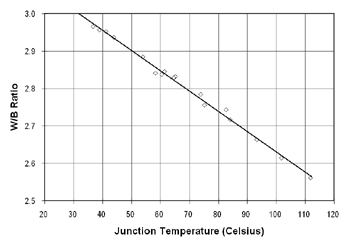
Non-contact Method for Determining Junction Temperature in White LEDs (2003)
White light-emitting diodes (LEDs) are rapidly evolving for use in general illumination applications and are making their way into numerous types of lighting systems. With this growing popularity comes the question of how long white LEDs will operate effectively in a system, considering that packaging, drive current, and environmental conditions all affect LED performance.
Estimating how long a white-LED system will last is not an easy task. One way is to measure the light output of the system over time and record when the light level drops below a specified value. This is a time-consuming process. Therefore, LRC researchers asked the question: What if system life could be estimated based on measurements of certain optical properties?
Because heat at the LED's p-n junction plays a significant role in the decline of light output and system life, the LRC chose to focus on ways to calculate junction temperature using non-invasive spectral measurements. A non-invasive method is important because it allows an LED system to remain in its stable operating state; disassembly could negatively affect the system and alter its long-term performance.
EXPERIMENT
Based on past studies, LRC researchers hypothesized that the junction temperature of GaN-based white LEDs could be predicted by the ratio of total white radiant energy (W) to blue radiant energy (B) of the LED's emission. Six commercial white LEDs (5 mm epoxy-encapsulated GaN+YAG Cerium phosphor) from the same manufacturing batch and with the same blue peak wavelength (466 nm) were assembled into an array and operated at various drive currents and ambient temperatures. The research team recorded the spectral power distribution and junction temperature of the array, and calculated the radiant energy W/B ratio. The experiment was repeated twice using LEDs with blue peak wavelengths of 459 nm and 461 nm.
CONCLUSIONS
- The LRC team found a proportional relationship between LED junction temperature and the W/B ratio (total radiant energy to blue radiant energy). This linear relationship holds true, even when the spectral characteristics of the LEDs are not identical.
- This ratio can be used as a direct, non-invasive measure of junction temperature in GaN-based white LED systems. Measuring the initial ambient temperature and the spectra at onset and at final operating conditions to determine the junction temperature allows an LED system to remain in stable operation.
- Application of this method, combined with forthcoming LED degradation rates, would mean that an LED's life in a system could be estimated without long-term testing.
SPONSOR
U.S. Department of Energy, DOE Grant #DE-FC26-01NT41203 and the University of California at Santa Barbara

Effect of junction temperature on W/B ratio (ratio of total radiant
energy to blue radiant energy) for a 5 mm GaN-based white LED with
a peak wavelength of 466 nm.
|


